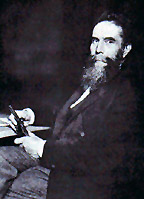Where does the "X" in "X-ray" come from?
Here's a piece of high-energy astrophysics trivia (you never know when you might need to know these things). Where does the "X" in "X-ray" come from?
The answer is that a German physicist, Wilhelm Roentgen, discovered a new form of radiation in 1895. He called it X-radiation because he didn't know what it was. Yes, it's as simple as that. This mysterious radiation had the ability to pass through many materials that absorb visible light. X-rays also have the ability to knock electrons loose from atoms. Over the years these exceptional properties have made X-rays useful in many fields, such as medicine and research into the nature of the atom. And then, of course, there's the Chandra X-ray Observatory. You can read more about X-rays and other types of light at https://chandra.harvard.edu/xray_astro/xrays.html.

German physicist Wilhelm Roentgen
While Wilhelm Roentgen obviously could never envision that his discovery would lead to anything like Chandra, he is connected to an earlier X-ray satellite. The German-American satellite known as ROSAT (short for Röntgensatellit) was named in his honor. ROSAT operated from June 1990 through February 1999 and astronomers are still using its X-ray data, which is often complementary to what Chandra observes.
